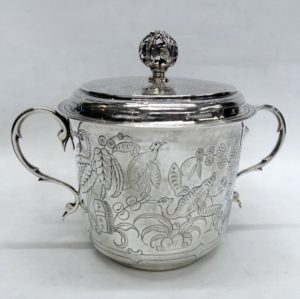Robert Frederick Fox
The founder of the firm was Charles Fox, neither apprenticed through the Goldsmiths’ Company nor a freeman of the Company. Charles Fox registered a mark in 1801 in partnership with James Turner and a his mark alone in 1804.
In 1822 he was succeeded by his son, Charles Fox II, no record of apprenticeship or freedom. 1st mark entered as plateworker 1822. 2nd 3rd, 4th and 5th marks 1823. 6th mark 1838. Known for his consistently high quality work.
His works shows consistently high quality and the rapid entry of marks suggests a fairly large establishment with varying marks used for different categories of work.
At the retirement of Charles Fox II the family business was took over by his sons Charles Thomas Fox (born 1801) and George Fox (born 1816). They entered conjoined marks in 1841 and 1843.
Charles Thomas Fox retired from the firm in 1860 and George Fox continued running the firm entering his own mark in 1861. Other marks were entered in 1869 and 1891.
After the death of George Fox his son Robert Frederick Fox (born 1845) continued the trade as C.T. & G. Fox entering his own mark in 1910. The firm closed down in 1921.
A separate silversmith business was managed by other members of Fox family. Frederick Fox (born 1810), another son of Charles Fox II, in 1852 entered his mark at Goldsmiths’ Hall entering in partnership with his son Frederick Yonge Fox (apprenticed to John Wilmin Figg, obtained freedom by service in 1852).
Frederick Fox retired in 1867 and Frederick Yonge Fox entered his own marks in 1868. This activity had presumably a short life as these marks were withdrawn in 1870.
Robert Frederick Fox
The founder of the firm was Charles Fox, neither apprenticed through the Goldsmiths’ Company nor a freeman of the Company. Charles Fox registered a mark in 1801 in partnership with James Turner and a his mark alone in 1804.
In 1822 he was succeeded by his son, Charles Fox II, no record of apprenticeship or freedom. 1st mark entered as plateworker 1822. 2nd 3rd, 4th and 5th marks 1823. 6th mark 1838. Known for his consistently high quality work.
His works shows consistently high quality and the rapid entry of marks suggests a fairly large establishment with varying marks used for different categories of work.
At the retirement of Charles Fox II the family business was took over by his sons Charles Thomas Fox (born 1801) and George Fox (born 1816). They entered conjoined marks in 1841 and 1843.
Charles Thomas Fox retired from the firm in 1860 and George Fox continued running the firm entering his own mark in 1861. Other marks were entered in 1869 and 1891.
After the death of George Fox his son Robert Frederick Fox (born 1845) continued the trade as C.T. & G. Fox entering his own mark in 1910. The firm closed down in 1921.
A separate silversmith business was managed by other members of Fox family. Frederick Fox (born 1810), another son of Charles Fox II, in 1852 entered his mark at Goldsmiths’ Hall entering in partnership with his son Frederick Yonge Fox (apprenticed to John Wilmin Figg, obtained freedom by service in 1852).
Frederick Fox retired in 1867 and Frederick Yonge Fox entered his own marks in 1868. This activity had presumably a short life as these marks were withdrawn in 1870.
-


1912
Robert Frederick Fox
9235 Antique Silver Porringer and Lid
Sold
A good size sterling silver bowl and cover in the late 17th century chinoiserie style. Engraved with a charming decoration of birds and foliage. Good gauge silver. Weight 569 grams, 18.2 troy ounces. Height 15 cm (to top of finial), 10.5 (top of body). Spread across handles 19.5 cm. Diameter of bowl 12.7 cms. Both pieces hallmarked London 1912. Maker Robert Frederick Fox.